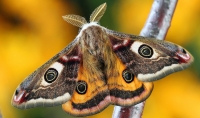In general, moths have duller wings compared to butterflies, but this evolutionary perk allows moths to blend into their environment. In Europe during the Industrial Revolution, coal-burning factories covered trees in black soot. This caused Peppered Moths with speckled black and white coloring to be visible on the darkened bark and more vulnerable to birds that feasted on the moths. Peppered Moths with completely black coloring camouflaged on the soot-covered bark and their population increased. This caused a change in the type of moth that was able to survive the anthropogenic change. This phenomenon is called "industrial melanism." It is an example of natural selection and an example of how one factor in moth survival is dependent on their ability to hide from predators. “Industrial melanism” is an event that mostly only occurs in moths with the exception of a few butterflies and one beetle.
Hummingbird Moth, seen in the Harbor District. Photo by Ethan Bott.
Like all life on Earth, moths play an important part in a variety of ecosystems. Moths and their larvae are a crucial food source for birds, bats, rodents, and amphibians. While moths are a needed food source for other life, they are also an indicator species and model species. Moths are sensitive to changes in their environment. Their decline in some ecosystems gives clues as to the health of the environment. Processionary Moths are used as an insect model to indicate the effects of global warming. The larvae of this moth are sensitive to changes in temperature. One study found that their natural range in Europe expanded when winters became warmer and favored the survival of the moth's larvae. This caused economic and ecological havoc on European forests. Although Processionary Moths are perceived as pests, they offer scientific value as a model organism.
Moths are also key pollinators of night-blooming plants. In Wisconsin, the Whitney's Underwing Moth is a vulnerable nocturnal species. Globally this species is listed as vulnerable but secure with some recent declines or threats according to the Wisconsin Natural Heritage Working List. The Whitney's Underwing Moth is a prairie species but can exist in xeric oak savanna wooded habitats. The Wisconsin Wildlife Action Plan rates dry prairie and oak openings as moderate to the Whitney's Underwing Moth's population. The Wisconsin Wildlife Action Plan is used to conserve rare and declining species and their habitats. This moth is found in Dane, Grant, Green, and Monroe counties.

Cecropia moth released in Riverside Park in 2018. Photo by Kim Forbeck.
Another moth of great concern is the Phlox Moth. In Wisconsin, it is listed as endangered and often is spotted with Karner Blue Butterflies. The Karner Blue Butterfly is another endangered species in the state of Wisconsin. The Wisconsin Natural Heritage Working List also lists the Phlox Moth as globally imperiled. Loss of dry-mesic savannas to increased tree plantings and pesticide spraying during the spring have decimated the Phlox Moths population. Phlox Moths flock to Downy Phlox, and their wing colors help them camouflage along with the flower buds. During the Phlox Moth larvae stage, larvae burrow into Downy Phlox flower buds and eventually feed on the flower's seeds. Removal or mowing of Downy Phlox has also affected the moth's numbers. The Wisconsin Wildlife Action Plan lists the natural communities, Dry-Mesic Prairie, Oak-Barrens, Pine Barrens, and Sand Prairie as high habitat associations. The protection of these natural habitats is needed to aid healthy populations of the Phlox Moth. Habitats that support the Phlox Moth also support the endangered Karner Blue Butterfly.
Moths can offer a surprising amount of information about the health of environments with their ability to be used as indicator species. Moths are crucial to supporting other wildlife, and their ability to adapt to their surroundings makes them a stunning life form to use for scientific discovery. Every moth seen contributes to ecosystems and there are a variety of opportunities to survey and record moths that are seen. Using iNaturalist or bugguide.net you can submit data of moth observations to scientists. Any number of moths seen counts no matter how small and if you look closely, you might even see the Whitney’s Underwing moth or the rare Phlox moth.
This blog is written by Elizabeth Gamillo, UEC Science Communication Intern.
Join us for our Nocturnal Yardversity event on Thursday, August 20, to contribute to our effort to record moths and other nocturnal creatures in our neighborhoods. Click here for more information.






